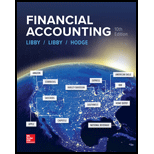
Concept explainers
1.
Record the sale of the bonds
1.
Explanation of Solution
Bonds:
Bonds are a kind of interest bearing notes payable, usually issued by companies, universities and governmental organizations. It is a debt instrument used for the purpose of raising fund of the corporations or governmental agencies. If selling price of the bond is equal to its face value, it is called as par on bond. If selling price of the bond is lesser than the face value, it is known as discount on bond. If selling price of the bond is greater than the face value, it is known as premium on bond.
Prepare
| Date | Account Titles and Explanation |
Debit ($) |
Credit ($) |
| Cash (1) | 1,135,907 | ||
| Premium on bonds payable (5) | 135,907 | ||
| Bonds payable | 1,000,000 | ||
| (To record the sale of bonds ) |
Table (1)
- Cash is an asset and it is increased. Therefore debit cash account by 1,135,907
- Premium on bonds payable is an adjunct liability and it is increased. Therefore credit premium on bonds payable by $135,907
- Bonds payable is a liability and it is increased. Therefore credit bonds payable by $1,000,000.
Prepare journal entry to record the sale of bonds without using a premium account.
| Date | Account Titles and Explanation |
Debit ($) |
Credit ($) |
| Cash (1) | 1,135,907 | ||
| Bonds payable | 1,135,907 | ||
| (To record the sale of bonds ) |
Table (2)
- Cash is an asset and it is increased. Therefore debit cash account by 1,135,907
- Bonds payable is a liability and it is increased. Therefore credit bonds payable by $1,135,907.
Working notes:
Calculate the issue price of bonds:
| Particulars | Amount ($) |
| Interest amount (2) | 50,000 |
| Present value of principal amount (3) | 456,390 |
| Present value of interest expense amount (4) | 679,517 |
| Issue price | 1,135,907 |
Table (3)
(1)
Calculate the Interest expense amount:
Calculate present value of principal amount.
Calculate present value of interest expense amount.
Calculate the premium on bonds payable:
2.
Record the issuance of stock
2.
Explanation of Solution
Issuance of stock:
It refers to the number of shares that are sold to the stockholders from number of shares authorized for issuance by the company.
Prepare journal entry to record issuance of stock.
| Date | Account Titles and Explanation | Debit ($) | Credit ($) |
| Cash (6) | 1,125,000 | ||
| Common stock (7) | 45,000 | ||
| Additional paid-in capital | 1,080,000 | ||
| (To record the issuance of stock) |
Table (4)
- Cash is an asset and it is increased. Therefore debit cash account by $1,125,000
- Common stock is a component of
stockholders equity and it is increased. Therefore, credittreasury stock by $45,000 - Additional paid-in capital is a component of stockholders equity and it is increased. Therefore, credit additional paid-in capital by $1,080,000.
Working notes:
Calculate the value of cash:
Calculate the value of common stock:
Want to see more full solutions like this?
Chapter 11 Solutions
Financial Accounting
- Orion Textiles Ltd. needs to estimate its total overhead costs for the next fiscal year. The actual machine hours and total overhead costs for the past six months are: January: $8,200 total overhead, 2,500 machine hours • February: $8,600 total overhead, 2,700 machine hours • March: $7,900 total overhead, 2,300 machine hours • April: $7,500 total overhead, 2,100 machine hours May: $8,000 total overhead, 2,400 machine hours June: $8,300 total overhead, 2,600 machine hours Using the high-low method, what is the variable overhead cost per machine hour?arrow_forwardKindly help me with accounting questionsarrow_forwardSolve this Accounting problemarrow_forward
- i need correct answer. please don't give incorrect data answer i will give unhelarrow_forwardMOH Cost: Top Dog Company has a budget with sales of 7,500 units and $3,400,000. Variable costs are budgeted at $1,850,000, and fixed overhead is budgeted at $970,000.What is the budgeted manufacturing cost per unit?answer this questionarrow_forwardWhat is net income using acurul accounting ?arrow_forward
- Don't use ai given answer accounting questionsarrow_forwardGeneral accounting questionarrow_forwardStandard costs are NOT used for: a. determining actual costs. b. preparing budgets and forecasts. c. evaluating the performance of workers and management. d. developing appropriate selling prices.arrow_forward
- General accountingarrow_forwardWhat is the ending inventory under variable costing for this general accounting question?arrow_forwardFusion Ltd. sold electronics on account for $72,000 and paid expenses totaling $30,000. What is Fusion's net income or net loss? a. Net income of $42,000 b. Net loss of $42,000 c. Net income of $72,000 d. Cannot determine from the data givenarrow_forward

 AccountingAccountingISBN:9781337272094Author:WARREN, Carl S., Reeve, James M., Duchac, Jonathan E.Publisher:Cengage Learning,
AccountingAccountingISBN:9781337272094Author:WARREN, Carl S., Reeve, James M., Duchac, Jonathan E.Publisher:Cengage Learning, Accounting Information SystemsAccountingISBN:9781337619202Author:Hall, James A.Publisher:Cengage Learning,
Accounting Information SystemsAccountingISBN:9781337619202Author:Hall, James A.Publisher:Cengage Learning, Horngren's Cost Accounting: A Managerial Emphasis...AccountingISBN:9780134475585Author:Srikant M. Datar, Madhav V. RajanPublisher:PEARSON
Horngren's Cost Accounting: A Managerial Emphasis...AccountingISBN:9780134475585Author:Srikant M. Datar, Madhav V. RajanPublisher:PEARSON Intermediate AccountingAccountingISBN:9781259722660Author:J. David Spiceland, Mark W. Nelson, Wayne M ThomasPublisher:McGraw-Hill Education
Intermediate AccountingAccountingISBN:9781259722660Author:J. David Spiceland, Mark W. Nelson, Wayne M ThomasPublisher:McGraw-Hill Education Financial and Managerial AccountingAccountingISBN:9781259726705Author:John J Wild, Ken W. Shaw, Barbara Chiappetta Fundamental Accounting PrinciplesPublisher:McGraw-Hill Education
Financial and Managerial AccountingAccountingISBN:9781259726705Author:John J Wild, Ken W. Shaw, Barbara Chiappetta Fundamental Accounting PrinciplesPublisher:McGraw-Hill Education





